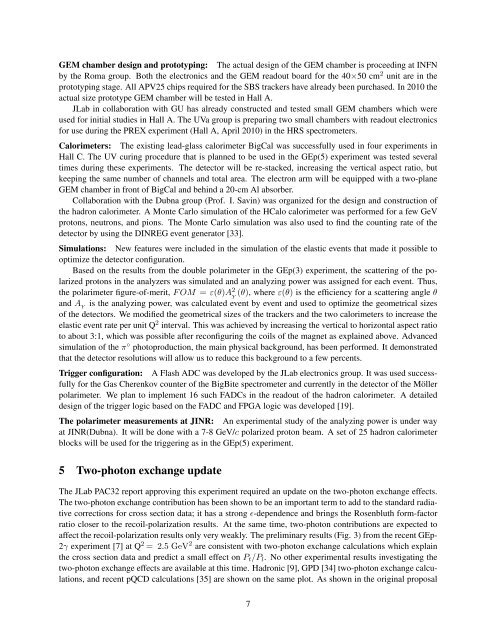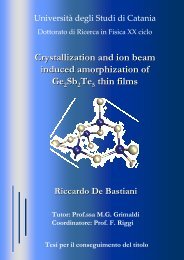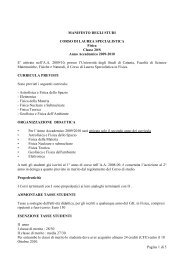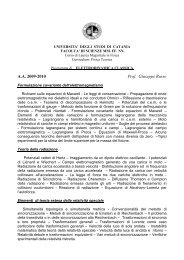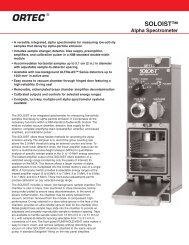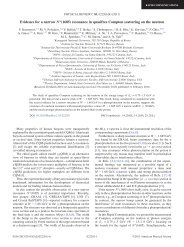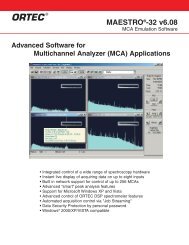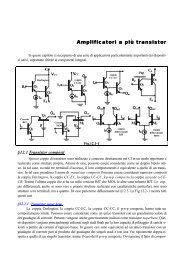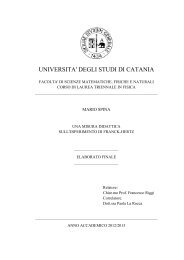Update on E12-07-109: Large Acceptance Proton Form Factor ... - Infn
Update on E12-07-109: Large Acceptance Proton Form Factor ... - Infn
Update on E12-07-109: Large Acceptance Proton Form Factor ... - Infn
Create successful ePaper yourself
Turn your PDF publications into a flip-book with our unique Google optimized e-Paper software.
GEM chamber design and prototyping: The actual design of the GEM chamber is proceeding at INFN<br />
by the Roma group. Both the electr<strong>on</strong>ics and the GEM readout board for the 40×50 cm 2 unit are in the<br />
prototyping stage. All APV25 chips required for the SBS trackers have already been purchased. In 2010 the<br />
actual size prototype GEM chamber will be tested in Hall A.<br />
JLab in collaborati<strong>on</strong> with GU has already c<strong>on</strong>structed and tested small GEM chambers which were<br />
used for initial studies in Hall A. The UVa group is preparing two small chambers with readout electr<strong>on</strong>ics<br />
for use during the PREX experiment (Hall A, April 2010) in the HRS spectrometers.<br />
Calorimeters: The existing lead-glass calorimeter BigCal was successfully used in four experiments in<br />
Hall C. The UV curing procedure that is planned to be used in the GEp(5) experiment was tested several<br />
times during these experiments. The detector will be re-stacked, increasing the vertical aspect ratio, but<br />
keeping the same number of channels and total area. The electr<strong>on</strong> arm will be equipped with a two-plane<br />
GEM chamber in fr<strong>on</strong>t of BigCal and behind a 20-cm Al absorber.<br />
Collaborati<strong>on</strong> with the Dubna group (Prof. I. Savin) was organized for the design and c<strong>on</strong>structi<strong>on</strong> of<br />
the hadr<strong>on</strong> calorimeter. A M<strong>on</strong>te Carlo simulati<strong>on</strong> of the HCalo calorimeter was performed for a few GeV<br />
prot<strong>on</strong>s, neutr<strong>on</strong>s, and pi<strong>on</strong>s. The M<strong>on</strong>te Carlo simulati<strong>on</strong> was also used to find the counting rate of the<br />
detector by using the DINREG event generator [33].<br />
Simulati<strong>on</strong>s: New features were included in the simulati<strong>on</strong> of the elastic events that made it possible to<br />
optimize the detector c<strong>on</strong>figurati<strong>on</strong>.<br />
Based <strong>on</strong> the results from the double polarimeter in the GEp(3) experiment, the scattering of the polarized<br />
prot<strong>on</strong>s in the analyzers was simulated and an analyzing power was assigned for each event. Thus,<br />
the polarimeter figure-of-merit, F OM = ε(θ)A2 (θ), where ε(θ) is the efficiency for a scattering angle θ<br />
Y<br />
and AY is the analyzing power, was calculated event by event and used to optimize the geometrical sizes<br />
of the detectors. We modified the geometrical sizes of the trackers and the two calorimeters to increase the<br />
elastic event rate per unit Q2 interval. This was achieved by increasing the vertical to horiz<strong>on</strong>tal aspect ratio<br />
to about 3:1, which was possible after rec<strong>on</strong>figuring the coils of the magnet as explained above. Advanced<br />
simulati<strong>on</strong> of the π◦ photoproducti<strong>on</strong>, the main physical background, has been performed. It dem<strong>on</strong>strated<br />
that the detector resoluti<strong>on</strong>s will allow us to reduce this background to a few percents.<br />
Trigger c<strong>on</strong>figurati<strong>on</strong>: A Flash ADC was developed by the JLab electr<strong>on</strong>ics group. It was used successfully<br />
for the Gas Cherenkov counter of the BigBite spectrometer and currently in the detector of the Möller<br />
polarimeter. We plan to implement 16 such FADCs in the readout of the hadr<strong>on</strong> calorimeter. A detailed<br />
design of the trigger logic based <strong>on</strong> the FADC and FPGA logic was developed [19].<br />
The polarimeter measurements at JINR: An experimental study of the analyzing power is under way<br />
at JINR(Dubna). It will be d<strong>on</strong>e with a 7-8 GeV/c polarized prot<strong>on</strong> beam. A set of 25 hadr<strong>on</strong> calorimeter<br />
blocks will be used for the triggering as in the GEp(5) experiment.<br />
5 Two-phot<strong>on</strong> exchange update<br />
The JLab PAC32 report approving this experiment required an update <strong>on</strong> the two-phot<strong>on</strong> exchange effects.<br />
The two-phot<strong>on</strong> exchange c<strong>on</strong>tributi<strong>on</strong> has been shown to be an important term to add to the standard radiative<br />
correcti<strong>on</strong>s for cross secti<strong>on</strong> data; it has a str<strong>on</strong>g ɛ-dependence and brings the Rosenbluth form-factor<br />
ratio closer to the recoil-polarizati<strong>on</strong> results. At the same time, two-phot<strong>on</strong> c<strong>on</strong>tributi<strong>on</strong>s are expected to<br />
affect the recoil-polarizati<strong>on</strong> results <strong>on</strong>ly very weakly. The preliminary results (Fig. 3) from the recent GEp-<br />
2γ experiment [7] at Q 2 = 2.5 GeV 2 are c<strong>on</strong>sistent with two-phot<strong>on</strong> exchange calculati<strong>on</strong>s which explain<br />
the cross secti<strong>on</strong> data and predict a small effect <strong>on</strong> Pt/Pl. No other experimental results investigating the<br />
two-phot<strong>on</strong> exchange effects are available at this time. Hadr<strong>on</strong>ic [9], GPD [34] two-phot<strong>on</strong> exchange calculati<strong>on</strong>s,<br />
and recent pQCD calculati<strong>on</strong>s [35] are shown <strong>on</strong> the same plot. As shown in the original proposal<br />
7


